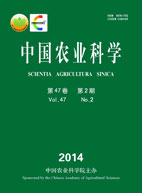-
Effect of Straw Incorporation Substitute for K-Fertilizer Under Different Paddy Soil K Supply Capacities
- LI Ji-Fu-1, LU Jian-Wei-1, REN Tao-1, CONG Ri-Huan-1, LI Xiao-Kun-1, ZHOU Li-1, YANG Wen-Bing-2, DAI Zhi-Gang-2
-
Scientia Agricultura Sinica. 2014, 47(2):
292-302.
doi:10.3864/j.issn.0578-1752.2014.02.009
-
 Abstract
(
617 )
Abstract
(
617 )
 HTML
(
4 )
HTML
(
4 )
 PDF (643KB)
(
908
)
PDF (643KB)
(
908
)
 Save
Save
-
References |
Related Articles |
Metrics
【Objective】In order to provide a scientific basis for crop residue management and K fertilization, the effect of straw incorporation plus K-fertilizer on yield of rice, potassium (K2O) accumulation amount of shoots and potassium efficiency under different paddy soil potassium levels was studied. 【Method】A series of field trials were carried out to study the effect of recommended rate of potassium (K2O 75 kg•hm-2) on rice production and whether straw potassium could replace chemical potassium under wheat-rice/rape-rice cropping systems in selected 10 counties in Ezhong, Jianghan plain and Edong regions during 2011-2012. According to the second national soil census in Hubei province, trial sites (available K content >150 mg•kg-1), Zhongxiang (ZX) and Yicheng (YC) were classified as high potassium supply capacity soils, marked as high-K; the test points (available K content 100-150 mg•kg-1), Tuanfeng (TF), Xiantao (XT), Honghu (HH) and Zhijiang (ZJ) were classified as middle potassium supply capacity soils, labeled as Middle-K; the test points (available K content <100 mg•kg-1), Macheng (MC), Guangshui (GS), Ezhou (EZ) and Qichun (QC) were normalized to low potassium supply capacity soil, labeled as Low-K. The field experiment was carried out in a randomized block design, including six treatments with three replications. The designed treatments were CK (-K), +K, +S, S+1/3K, S+2/3K, and S+K, where K and S denoted K fertilizer and straw, respectively. 【Result】The results showed that the yield of CK treatment for high-K, middle-K and low-K soil were 8372, 8710 and 7767 kg•hm-2, respectively. However, the K-fertilizer and straw returning to field could increase yield of rice and K accumulation amount of shoots at varying degrees. The straw incorporation with K-fertilizer treatment got the best effect compared with CK treatment. The increased yields were 633, 1098 and 814 kg•hm-2, respectively and the yield increase rates were 7.7%, 12.6% and 12.5%, respectively for high-K, middle-K and low-K soils. The increased K accumulations were 40.2, 56.5 and 49.3 kg?hm-2 and the K increase rates were 15.9%, 21.3% and 36.8%, respectively. Straw incorporation could reduce the KfRE (K fertilizer recovery efficiency) of high-K soil, but increase the KfRE of middle-K and low-K soils, significantly. Meanwhile, straw returning to field also lowered the KfAE (K fertilizer agronomic efficiency) of high-K soil, but enhanced the KfAE of others. Compared with KfRE and KfAE, the KRE and KAE (K efficiency of straw-K with chemical-K) were reduced, but the KRE and KAE of middle-K and low-K soils were obviously higher than those of high-K soil. Under the straw returning to field condition, the correlation analysis between increase of yield, K accumulation and K-fertilizer amount indicated that the recommended rate of potassium was more than the actual demand of rice growth in high-K soil and middle-K soil. Using the fertilizer efficiency model and considering straw returning to field, the optimal amount of K-fertilizer was 38.2 kg•hm-2 for high-K soil (available potassium content>150 mg•kg-1), which was 49.1% less than the recommended amount in Hubei province. In the same way, the optimal amount of K-fertilizer was 60.0 kg•hm-2 for middle-K soil (available potassium content 100-150 mg•kg-1), which was 20.0% less than the recommended amount. Whereas for low-K soil (available potassium content<100 mg•kg-1), the current recommended amount of K-fertilizer was deficient. 【Conclusion】 It was concluded that straw potassium could replace partial chemical potassium for higher soil K supply, but insufficient for lower soil K supply if more grain wants to be produced in short-term of straw incorporation.









